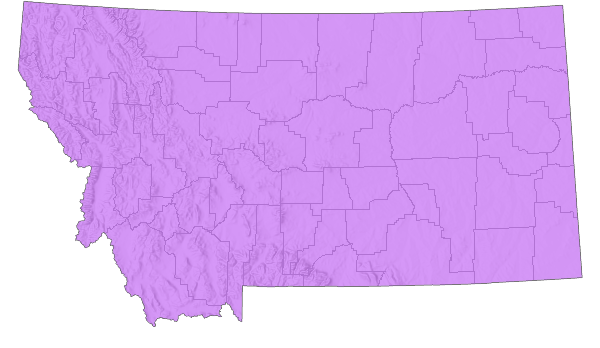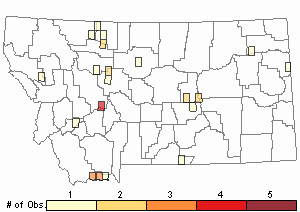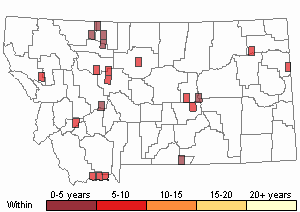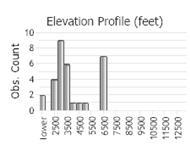View in other NatureServe Network Field Guides
NatureServe
Montana
Utah
Wyoming
Idaho
Wisconsin
British Columbia
South Carolina
Yukon
California
New York
Kirby's Tiger Beetle - Cicindela tranquebarica kirbyi
General Description
The following is taken from Wallis (1961), Kippenhan (1994), Kritsky and Horner (1998), Acorn (2001), and Pearson et al. (2015). Body length is 12-15 mm, and variable in size. Color is reddish-brown to dark brown or green above. Maculations are complete and usually wide and distinct, a long oblique shoulder (humeral) maculation running toward the midline with the rear tip not expanded, sometimes with a complete or partial marginal band on the outer edge of the elytra. Ventral surfaces are metallic deep blue-green to purple on abdomen, often with copper on sides of thorax. Hairy forehead with erect setae, short upper lip, labrum short with 3 teeth.
Phenology
Tiger beetle life cycles fit two general categories based on adult activity periods. “Spring-fall” beetles emerge as adults in late summer and fall, then overwinter in burrows before emerging again in spring when mature and ready to mate and lay eggs. The life cycle may take 1-4 years. “Summer” beetles emerge as adults in early summer, then mate and lay eggs before dying. The life cycle may take 1-2 years, possibly longer depending on latitude and elevation (Kippenhan 1994, Knisley and Schultz 1997, and Leonard and Bell 1999). Adult Cicindela tranquebarica kirbyi found in March-June and again September (Larochelle and Larivière 2001). April to September in Nebraska (Carter 1989), late March to late October in Colorado (Kippenhan 1994). In Montana it probably varies with elevation, from mid-March to late September (Hendricks and Roedel 2001, Hendricks and Lesica 2007, Winton 2010, Nate Kohler personal communication, iNaturalist 2023).
Diagnostic Characteristics
The following comes largely from Wallis (1961), Kritsky and Horner (1998), Acorn (2001), and Pearson et al. (2015). For our region, the long obliquely-descending arm of the shoulder (humeral) maculation on the dark elytra differentiates this species from all others. The
Blowout Tiger Beetle (
C. lengi) has a longer upper lip and a thicker shoulder maculation near the shoulder itself. The
Crimson Saltflat Tiger Beetle (
C. fulgida) is smaller, more shiny, and with a thicker shoulder maculation.
C. t. kirbyi differs from
C. t. vibex (= borealis), the other subspecies of Oblique-lined Tiger Beetle in Montana, by being dark brown above with wide maculations (including a thicker shoulder maculation), instead of dark brown or dark green to black with a relatively thin shoulder maculation.
C. t. vibex (= borealis) apparently occurs only west of the Continental Divide, not in the eastern prairies. Validity of several subspecies designations is in need of reevaluation (Sumlin 1976, Kippenhan 1994, Kritsky and Horner 1998, Acorn 2001, Knisley and Haines 2007, and Pearson et al. 2015) although
C. t. kirbyi is accepted by all authorities.
Species Range
Montana Range
Range Descriptions

 Native
Native
Range Comments
Found mostly east of the Rocky Mountains in the Great Plains of the U.S. and Canada; widely overlaps with C. t. tranquibarica in the east and narrowly with C. t. vibex (= borealis) in the west (Kritsky and Horner 1998, and Pearson et al. 2015). Intergradation with other subspecies makes range limits uncertain. In Montana, occurs east of the Continental Divide in appropriate habitats, to at least 6700 ft (2042 m) elevation (Hendricks and Lesica 2007, Winton 2010, Nate Kohler personal communication, and iNaturalist 2023). Distribution west of the Continental Divide needs additional study and documentation, although included in the latest range assessment (Pearson et al. 2015).
Observations in Montana Natural Heritage Program Database
Number of Observations: 31
(Click on the following maps and charts to see full sized version)
Map Help and Descriptions
Relative Density

Recency



 (Observations spanning multiple months or years are excluded from time charts)
(Observations spanning multiple months or years are excluded from time charts)
Migration
Non-migratory but capable of dispersal. When wings are fully developed (macropterous), it is a strong agile flier and fast runner. Can colonize newly available habitats within 20 years (Kritsky and Horner 1998, and Larochelle and Larivière 2001).
Habitat
Adult and larval tiger beetle habitat is essentially identical, the larvae live in soil burrows (Knisley and Schultz 1997). Across the range, Cicindela tranquebarica kirbyi occurs in a variety of habitats including clay banks and mud flats of creeks and rivers, dry lake beds, saline and alkali flats, blowouts, sand pits, vacant lots, in prairie grasslands and along forest trails, usually near water (Vaurie 1950, Wallis 1961, Ferris 1969, Hooper 1969, Kirk and Balsbaugh 1975, Knisley 1984, Carter 1989, Kippenhan 1994, Acorn 2001, Larochelle and Larivière 2001, Kritsky and Smith 2005, and Pearson et al. 2015). In Montana, has been documented in habitats including sedge-grass sand flats, hard-packed gravelly-sandy roads near water, along creeks and ditches, saline/alkali flats, riparian dunes, sandy blowouts, river sandbars, and old river crossings (Hendricks and Roedel 2001, Hendricks and Lesica 2007, Winton 2010, and Nate Kohler personal communication).
Food Habits
Larval and adult tiger beetles are predaceous. In general, both feed considerably on ants (Wallis 1961, and Knisley and Schultz 1997). Larval Cicindela tranquebarica kirbyi diet is not described but probably includes a variety of small insects and spiders. Adults in the field feed on ants, beetles, aphids, and cutworms. In captivity, they feed on small crickets (Criddle 1907, and Larochelle and Larivière 2001). Adults are likely to feed on a variety of other small insects and spiders.
Ecology
Larval tiger beetles live in burrows and molt through three instars to pupation, which also occurs in the larval burrow. Adults make shallow burrows in soil for overnight protection, deeper burrows for overwintering. Adults are sensitive to heat and light and most active during sunny conditions. Excessive heat during midday on sunny days drives adults to seek shelter among vegetation or in burrows (Wallis 1961, and Knisley and Schultz 1997).
Cicindela tranquebarica kirbyi has a broad range of ecological tolerance (eurytopic). Adults are diurnal, and gregarious (Larochelle and Larivière 2001). Stilts (stands high on legs with head elevated) or hides during hottest parts of the day on high beaches away from water, sometimes occupies burrows on rainy days. Predators of adults not described but probably include birds and robber (asilid) flies. Larval parasites probably include bombyliid flies. Escapes by flying rapidly short distances (3-10 m) undulating from side to side, turns to face pursuer once landing then seeks cover quickly. Wary and difficult to approach (Vaurie 1950, Ferris 1969, Larochelle and Larivière 2001). Associated tiger beetle species include
Cicindela decemnotata,
C. denverensis,
C. duodecimguttata,
C. formosa,
C. fulgida,
C. hirticollis,
C. lengi,
C. limbata,
C. nebraskana,
C. (=Ellipsoptera) nevadica,
C. oregona,
C. purpurea,
C. repanda,
C. scutellaris, and
C. (=Parvindela) terricola (Kippenhan 1994, Larochelle and Larivière 2001, and Kritsky and Smith 2005);
C. repanda an observed associate in Montana (Paul Hendricks personal observation).
Reproductive Characteristics
The life cycle of Cicindela tranquebarica kirbyi is 2 years, with both third instar larvae and teneral adults overwintering (Acorn 2001, Larochelle and Larivière 2001, and Pearson et al. 2015). Little information on many reproductive characteristics, but probably similar to other subspecies (see the full species account). Mating is probably May to August (Vaurie 1950, and Larochelle and Larivière 2001). Females typically oviposit in sites where the water table is near the ground surface, often in moist, sandy soil that is sparsely vegetated and contains some humus. Larval burrows are straight and 22-50 cm deep. Tenerals (fresh adults) appear in August then overwinter and reemerge the following spring to mate. Adults overwinter in burrows 28-61 cm deep in sand, 15-30 cm deep in clay, larvae in burrows 46-51 cm deep. Duration of larval life 12-15 months, of adult life about 11 months (Criddle 1907, 1910, and Larochelle and Larivière 2001). In Montana, mating observed at 6660 ft (2030 m) elevation during mornings in late May to at least early July on sunny days when air temperatures were 18-21°C (Hendricks and Roedel 2001, Hendricks and Lesica 2007, and Hendricks personal observation).
Management
Not considered rare or in need of special conservation management overall (Knisley et al. 2014). Benefits from many man-made habitats, including agricultural fields and pastures, rangelands, sand and gravel pits, clay roads, powerline corridors. Native habitats favored by this species experience vegetation encroachment and stabilization as succession proceeds, especially from shrubs and trees which cast too much shade on larval burrows, and benefit from disturbance that retains a variety of succession conditions. Some colonies (particularly the larval burrows) could be impacted by trampling through livestock overgrazing, but grazing at appropriate times and stocking levels could also be beneficial by keeping vegetation cover more open (Knisley 2011). Prescribed fire is also a useful tool for maintaining a variety of successional conditions (Winton 2010).
Stewardship Responsibility
References
- Literature Cited AboveLegend:
 View Online Publication
View Online Publication Acorn, J. 2001. Tiger beetles of Alberta: killers on the clay, stalkers on the sand. The University of Alberta Press, Edmonton, Alberta. 120 p.
Acorn, J. 2001. Tiger beetles of Alberta: killers on the clay, stalkers on the sand. The University of Alberta Press, Edmonton, Alberta. 120 p. Carter, M. R. 1989. The biology and ecology of the tiger beetles (Coleoptera: Cicindelidae) of Nebraska. Transactions of the Nebraska Academy of Sciences XVII: 1-18.
Carter, M. R. 1989. The biology and ecology of the tiger beetles (Coleoptera: Cicindelidae) of Nebraska. Transactions of the Nebraska Academy of Sciences XVII: 1-18. Criddle, N. 1907. Habits of some Manitoba 'tiger beetles' (Cicindela). Canadian Entomologist 39:105-114.
Criddle, N. 1907. Habits of some Manitoba 'tiger beetles' (Cicindela). Canadian Entomologist 39:105-114. Criddle, N. 1910. Habits of some Manitoba tiger beetles (Cicindelidae). Canadian Entomologist 42(2):9-15.
Criddle, N. 1910. Habits of some Manitoba tiger beetles (Cicindelidae). Canadian Entomologist 42(2):9-15. Ferris, C.D. 1969. Notes on collecting early Cicindela in eastern Wyoming. Cicindela 1:9-13.
Ferris, C.D. 1969. Notes on collecting early Cicindela in eastern Wyoming. Cicindela 1:9-13. Hendricks, P. and M. Roedel. 2001. A faunal survey of the Centennial Valley Sandhills, Beaverhead County, Montana. Report to the U.S. Bureau of Land Management and U.S. Fish and Wildlife Service. Montana Natural Heritage Program, Helena, MT. 44 p.
Hendricks, P. and M. Roedel. 2001. A faunal survey of the Centennial Valley Sandhills, Beaverhead County, Montana. Report to the U.S. Bureau of Land Management and U.S. Fish and Wildlife Service. Montana Natural Heritage Program, Helena, MT. 44 p. Hendricks, P. Personal tiger beetle observations.
Hendricks, P. Personal tiger beetle observations. Hendricks, P.D. and P. Lesica. 2007. A disjunct population of Cicindela formosa (Say) in southwestern Montana, U.S.A. (Coleoptera: Cicindelidae). Cicindela. 39:53-58.
Hendricks, P.D. and P. Lesica. 2007. A disjunct population of Cicindela formosa (Say) in southwestern Montana, U.S.A. (Coleoptera: Cicindelidae). Cicindela. 39:53-58. Hooper, R.R. 1969. A review of Saskatchewan tiger beetles. Cicindela 1(4):1-5.
Hooper, R.R. 1969. A review of Saskatchewan tiger beetles. Cicindela 1(4):1-5. iNaturalist. Research-grade Observations. Accessed 5 November 2023. https://www.inaturalist.org/
iNaturalist. Research-grade Observations. Accessed 5 November 2023. https://www.inaturalist.org/ Kippenhan, Michael G. 1994. The Tiger Beetles (Coleoptera: Cicindelidae) of Colorado. 1994. Transactions of the American Entomological Society 120(1):1-86.
Kippenhan, Michael G. 1994. The Tiger Beetles (Coleoptera: Cicindelidae) of Colorado. 1994. Transactions of the American Entomological Society 120(1):1-86. Kirk, V.M. and E.U. Balsbaugh, Jr. 1975. A list of beetles of South Dakota. Brookings, SD: South Dakota State University. Agricultural Experiment Station, Technical Bulletin 42. 139 pages.
Kirk, V.M. and E.U. Balsbaugh, Jr. 1975. A list of beetles of South Dakota. Brookings, SD: South Dakota State University. Agricultural Experiment Station, Technical Bulletin 42. 139 pages. Knisley, C.B. 1984. Ecological distribution of tiger beetles (Coleoptera: Cicindelidae) in Colfax County, New Mexico. The Southwestern Naturalist 29(1):93-104.
Knisley, C.B. 1984. Ecological distribution of tiger beetles (Coleoptera: Cicindelidae) in Colfax County, New Mexico. The Southwestern Naturalist 29(1):93-104. Knisley, C.B. 2011. Anthropogenic disturbances and rare tiger beetle habitats: benefits, risks, and implications for conservation. Terrestrial Arthropod Reviews 4:41-61.
Knisley, C.B. 2011. Anthropogenic disturbances and rare tiger beetle habitats: benefits, risks, and implications for conservation. Terrestrial Arthropod Reviews 4:41-61. Knisley, C.B. and R.D. Haines. 2007. Description and conservation status of a new subspecies of Cicindela tranquebarica (Coleoptera: Cicindelidae), from the San Joaquin Valley of California, U.S.A. Entomological News 118(2):109-126.
Knisley, C.B. and R.D. Haines. 2007. Description and conservation status of a new subspecies of Cicindela tranquebarica (Coleoptera: Cicindelidae), from the San Joaquin Valley of California, U.S.A. Entomological News 118(2):109-126. Knisley, C.B., and T.D. Schultz. 1997. The biology of tiger beetles and a guide to the species of the south Atlantic states. Virginia Museum of Natural History Special Publication Number 5. 210 p.
Knisley, C.B., and T.D. Schultz. 1997. The biology of tiger beetles and a guide to the species of the south Atlantic states. Virginia Museum of Natural History Special Publication Number 5. 210 p. Knisley, C.B., M. Kippenhan, and D. Brzoska. 2014. Conservation status of United States tiger beetles. Terrestrial Arthropod Reviews 7:93-145.
Knisley, C.B., M. Kippenhan, and D. Brzoska. 2014. Conservation status of United States tiger beetles. Terrestrial Arthropod Reviews 7:93-145. Kohler, Nathan S. Excel spreadsheets of tiger beetle observations. 6 August 2022.
Kohler, Nathan S. Excel spreadsheets of tiger beetle observations. 6 August 2022. Kritsky, G. and J. Smith. 2005. Teddy's tigers: the Cicindelidae (Coleoptera) of Theodore Roosevelt National Park, North Dakota. Cicindela 37(1-2):1-16
Kritsky, G. and J. Smith. 2005. Teddy's tigers: the Cicindelidae (Coleoptera) of Theodore Roosevelt National Park, North Dakota. Cicindela 37(1-2):1-16 Kritsky, Gene and Leslie Horner, 1998. Geographic variation in Cicindela tranquebarica Herbst (Coleoptera: Cicindelidae). Cicindela 30 (3-4): 13-32.
Kritsky, Gene and Leslie Horner, 1998. Geographic variation in Cicindela tranquebarica Herbst (Coleoptera: Cicindelidae). Cicindela 30 (3-4): 13-32. Larochelle, A and M Lariviere. 2001. Natural history of the tiger beetles of North America north of Mexico. Cicindela. 33:41-162.
Larochelle, A and M Lariviere. 2001. Natural history of the tiger beetles of North America north of Mexico. Cicindela. 33:41-162. Leonard, Jonathan G. and Ross T. Bell, 1999. Northeastern Tiger Beetles: a field guide to tiger beetles of New England and eastern Canada. Boca Raton, FL: CRC Press. 176 p.
Leonard, Jonathan G. and Ross T. Bell, 1999. Northeastern Tiger Beetles: a field guide to tiger beetles of New England and eastern Canada. Boca Raton, FL: CRC Press. 176 p. Pearson, D.L., C.B. Knisley, D.P. Duran, and C.J. Kazilek. 2015. A field guide to the tiger beetles of the United States and Canada, second edition. New York, NY: Oxford University Press. 251 p.
Pearson, D.L., C.B. Knisley, D.P. Duran, and C.J. Kazilek. 2015. A field guide to the tiger beetles of the United States and Canada, second edition. New York, NY: Oxford University Press. 251 p. Sumlin, W.D. III. 1976. Notes on the tiger beetle holdings of the Nevada state Department of Agriculture (Coleoptera: Cicndelidae). The Coleopterists Bulletin 30(1):101-106.
Sumlin, W.D. III. 1976. Notes on the tiger beetle holdings of the Nevada state Department of Agriculture (Coleoptera: Cicndelidae). The Coleopterists Bulletin 30(1):101-106. Vaurie, P. 1950. Notes on the habitats of some North American tiger beetles. Journal of the New York Entomological Society 58(3):143-153.
Vaurie, P. 1950. Notes on the habitats of some North American tiger beetles. Journal of the New York Entomological Society 58(3):143-153. Wallis, J.B. 1961. The Cicindelidae of Canada. Toronto, Ontario, Canada: University of Toronto Press. 74 p.
Wallis, J.B. 1961. The Cicindelidae of Canada. Toronto, Ontario, Canada: University of Toronto Press. 74 p. Winton, R.C. 2010. The effects of succession and disturbance on Coleopteran abundance and diversity in the Centennial Sandhills. M.Sc. Thesis. Montana State University. Bozeman, MT. 77pp + Appendices.
Winton, R.C. 2010. The effects of succession and disturbance on Coleopteran abundance and diversity in the Centennial Sandhills. M.Sc. Thesis. Montana State University. Bozeman, MT. 77pp + Appendices.
- Additional ReferencesLegend:
 View Online Publication
View Online Publication
Do you know of a citation we're missing? Bousquet, Yves. 2012. Catalogue of Geadephaga (Coleoptera; Adephaga) of America north of Mexico. ZooKeys. 245:1-1722.
Bousquet, Yves. 2012. Catalogue of Geadephaga (Coleoptera; Adephaga) of America north of Mexico. ZooKeys. 245:1-1722. Brown, C.R. and T.C. MacRae. 2005. Occurrence of Cicindela (Cicindelidia) trifasciata ascendens Le Conte (Coleoptera:Cicindelidae) in Missouri. Cicindela 37(1-2):17-19.
Brown, C.R. and T.C. MacRae. 2005. Occurrence of Cicindela (Cicindelidia) trifasciata ascendens Le Conte (Coleoptera:Cicindelidae) in Missouri. Cicindela 37(1-2):17-19. Brust, M.L. and W.W. Hoback. 2009. Hypoxia tolerance in adult and larval Cicindela tiger beetles varies by life history but not habitat association. Annals of the Entomological Society of America 102(3):462-466.
Brust, M.L. and W.W. Hoback. 2009. Hypoxia tolerance in adult and larval Cicindela tiger beetles varies by life history but not habitat association. Annals of the Entomological Society of America 102(3):462-466. Brust, M.L., C.B. Knisley, S.M. Spomer, and K. Miwa. 2012b. Observations of oviposition behavior among North American tiger beetle (Coleoptera: Carabidae: Cicindelinae) species and notes on mass rearing. The Coleopterists Bulletin 66(4):309-314.
Brust, M.L., C.B. Knisley, S.M. Spomer, and K. Miwa. 2012b. Observations of oviposition behavior among North American tiger beetle (Coleoptera: Carabidae: Cicindelinae) species and notes on mass rearing. The Coleopterists Bulletin 66(4):309-314. Graves, R.C. and D.W. Brzoska. 1991. The tiger beetles of Ohio (Coleoptera: Cicindelidae). Bulletin of the Ohio Biological Survey New Series 8. 42 p.
Graves, R.C. and D.W. Brzoska. 1991. The tiger beetles of Ohio (Coleoptera: Cicindelidae). Bulletin of the Ohio Biological Survey New Series 8. 42 p. Pearson, D.L., C.B. Knisley, and C.J. Kazilek. 2006. A field guide to the tiger beetles of the United States and Canada: identification, natural history, and distribution of the Cicindelidae. Oxford University Press, New York, New York. 227 pp.
Pearson, D.L., C.B. Knisley, and C.J. Kazilek. 2006. A field guide to the tiger beetles of the United States and Canada: identification, natural history, and distribution of the Cicindelidae. Oxford University Press, New York, New York. 227 pp. Schultz, T.D. and N.F. Hadley. 1987. Microhabitat segregation and physiological differences in co-occurring tiger beetle species, Cicindela oregona and Cicindela tranquebarica. Oecologia 73:363-370.
Schultz, T.D. and N.F. Hadley. 1987. Microhabitat segregation and physiological differences in co-occurring tiger beetle species, Cicindela oregona and Cicindela tranquebarica. Oecologia 73:363-370. Shelford, V.E. 1907. Preliminary note on the distribution of the tiger beetles (Cicindela) and its relation to plant succession. Biological Bulletin 14:9-14.
Shelford, V.E. 1907. Preliminary note on the distribution of the tiger beetles (Cicindela) and its relation to plant succession. Biological Bulletin 14:9-14. Shelford, V.E. 1908. Life-histories and larval habits of the tiger beetles (Cicindelidae). The Journal of the Linnean Society 30:157-184.
Shelford, V.E. 1908. Life-histories and larval habits of the tiger beetles (Cicindelidae). The Journal of the Linnean Society 30:157-184.
- Web Search Engines for Articles on "Kirby's Tiger Beetle"
- Additional Sources of Information Related to "Insects"





